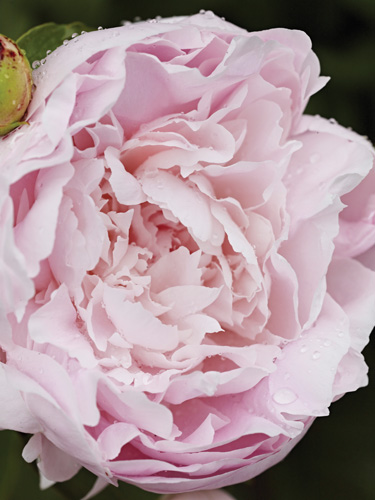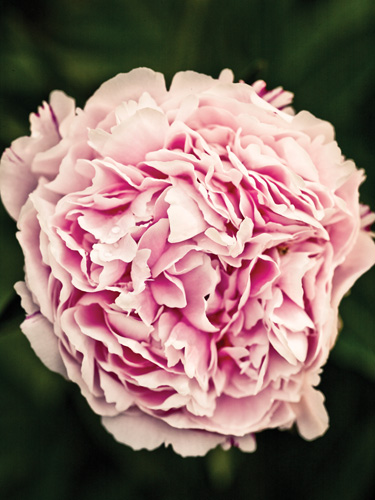


Peonies are the most voluptuous of flowers full, ruffled, petticoated, and fragrant, like beguiling Southern belles in hoop-skirted gowns or debutantes dressed for the cotillion.
The rare sight of a field full of peonies evokes a ballroom awhirl with waltzing frocks in party-dress shades of white, blush, pink, and deep wine.
That colorful dance begins next month at the Nichols Arboretum on the University of Michigan campus in Ann Arbor, where garden beds will be awash in the blooms of North America’s largest public display of heirloom peonies.
For some, it’s a nearly swoon-inducing experience. Visiting enthusiasts have been known to react as if encountering a long-lost love, gazing at a blushing pink face and gasping: “That’s Silvia Saunders,” referring to the rare variety named for the daughter of famed Canadian hybridizer Arthur Percy Saunders.


The Nichols collection was made possible because the beauties caught the fancy of Kalamazoo pharmaceutical magnate W.E. Upjohn, who collected peonies at his Augusta, Mich., estate, Brook Lodge.
In 1922, Upjohn donated hundreds of the plants to the University of Michigan, where they thrive, with 270 peonies erupting in pastel glory every spring. This year marks the 90th anniversary of Upjohn’s gift to the school. The U-M Peony Garden, designed by former Arboretum director Aubrey Tealdi, was opened to the public in 1927.
Upjohn reportedly grew as many as 675 peony varieties on 40 acres at his home. Today, his botanical legacy attracts passersby, students, nearby workers who spend lunch hours among the flowers, and visitors who travel miles to experience the antique varieties, many no longer available for purchase from plant nurseries.
Although peonies are famously reliable and undemanding, which adds to their appeal for home gardeners, maintaining the 27 beds at Nichols is a complex task of horticultural sleuth work, one that takes on almost archeological aspects.
The Peony Garden is undergoing an identification and conservation project designed to establish it as an internationally recognized living reference, as well as a destination for enthusiasts.


Working with an advisory board of experts and armed with planting maps of the peony beds from various years (1927, 1949, and the 1970s), project participants are endeavoring to properly identify every plant. About 50 mystery plants live in the beds.
“We look at each plant and do a checklist, almost like a reverse key,” says Carmen Leskoviansky, Collections and Natural Areas Specialist for the Matthaei Botanical Gardens and Nichols Arboretum. “It’s a long, complicated, and confusing project.”
A restoration effort, also under way, seeks to replace peonies that were removed or lost over the years. The garden accepts donations of heirloom plants (World War II era or earlier, with an emphasis on varieties from the late 1800s and early 1900s).


“We have a list of plants we want that are no longer in the trade,” says Leskoviansky, a horticulturist. In addition to the detailed research and physical upkeep, working amid the peonies is also pure pleasure. “The whole week they’re in bloom, it’s a joy to be out there,” Leskoviansky says. “I also love the history, the historic American Peony Society bulletins and historic garden magazines and articles and older peony books.”
Are there favorites among her charges? Yes: Pallas, Ella Christiansen (“looks like strawberry ice cream”), and Departing Sun.
Robert E. Grese, a University of Michigan professor of landscape architecture and director of the Botanical Gardens and Arboretum, says plants can disappear as they fall from popularity. Nurseries stop growing varieties that don’t sell well. Keeping plants alive preserves a cultural history of what people valued, he says
While maintaining peonies for the long term, there is also the fleeting nature to keep in mind. “There’s this huge showy mass that doesn’t last very long,” Grese says. “When peonies are in bloom, you have to enjoy them. Things that are temporal, you have to enjoy at their peak.”

The Peony Garden at the Nichols Arboretum in Ann Arbor usually blooms mid-May to early to mid-June. Times vary yearly depending on weather. Peony sale, June 2, 9-3:30 a.m.; festival, June 2-10; 734-647-7600, lsa.umich.edu/mbg.
- Peonies are not native to America. They’re originally from China, where they’re virtually the national flower and often appear in Chinese art. Peonies are also highly popular in Japan and Korea. They came to the North America via Europe.
- Peonies are classified as an herbaceous perennial. There are tree peonies, which are actually woody shrubs. The tree can be a bit trickier to grow than the herbaceous type.
- Peonies love cold winters and a mild, warm spring. They need the cold to flower, meaning they don’t do well in southern U.S. states.
- Older varieties are more fragrant; newer ones are bred for sturdier stems.
- For all general purposes, peonies are like small shrubs. They can be massed in a landscape.
- People often ask if ants help the buds by tickling them to open. But the ants, commonly seen on the golf-ball size buds, are enjoying the excess stored nutrients that emerge as sticky sweet syrup on the bud.
- Peonies are extremely hardy and are known for being passed down from generation to generation. Early American pioneers often took them from home to replant farther west.
Sources: Robert Grese and Carmen Leskoviansky
- In 1923, Alice Howard Harding, the esteemed East Coast gardener and garden writer, published Peonies in the Little Garden, a classic that remains highly regarded and still in print. Some excerpts:
- “No garden can really be too small to hold a peony. Had I but four square feet of ground at my disposal, I would plant a peony in the centre and proceed to worship.”
- “Festiva Maxima [Festiva Maxima (Mielles, 1851) peony] should be in every garden, large or small, lavishly arrayed or economically furnished.”
- “Many a little garden contains at least one peach tree. Sometimes there are several. In my own experience, I have found that peach trees make ideal protection for peonies.”
- A Short List of Fragrant Peonies: Albert Crousse, La Fée, Asa Gray, La France, Avalanche, La Perle, Baroness Schroeder, Mme. de Verneville, Duchesse de Nemours, Mme. Émile Lemoine, Gismonda, Octavie Demay, Grandiflora (Richardson), Philomèle, James Kelway, Primevère, Kelway’s Glorious, Splendida.
- A Short List of Delicately Beautiful Peonies for Cutting: Eugénie Verdier, Mireille, Frances Willard, Mme. Calot, Ginette, Mme. Jules Dessert, La Lorraine, Mrs. C.S. Minot, Le Cygne, Solange, Marie Crousse, Souvenir de Louis Bigot, Martha Bulloch, Thérèse, Milton Hill, Walter Faxon.
If you enjoy the monthly content in Hour Detroit, “Like” us on Facebook and/or follow us on Twitter for more frequent updates.
|
|
|









